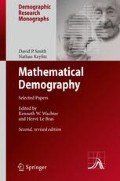Abstract
As Robert K. Merton (1973) has so well discussed, creative scientists are not immune to preoccupation with priorities: their priorities. Alfred J. Lotka (1880 to 1949), the father of self-renewal models in linear population analysis, was least of all an exception in this regard. A lone pioneer throughout much of his career, 1 with no cadre of graduate students and colleagues, he could naturally be expected to be prickly over failures to recognize and acknowledge his important contributions to demography.
Access this chapter
Tax calculation will be finalised at checkout
Purchases are for personal use only
Preview
Unable to display preview. Download preview PDF.
References
Bernardelli, H.: Population Waves. Journal of the Burma Research Society 31, Part I, 1–18 (1941 ).
Bockh, R.: Statistik des Jahres 1884. Statistisches Jahrbuch der Stadt Berlin, Volume 12 (Berlin) (1886).
Bortkiewicz, L. V.: Die Sterbeziffer und der Frauenüberschuβ in der stationären und in der progressiven Beviilkerung. Bulletin de I’Institut International de Statistique 19, 63–183 (1911 ).
Cannan, E.: The probability of a Cessation of the Growth of Population in England and Wales during the Next Century. Economic Journal 5, 505–15 (1895).
Coale, A.J.: The Growth and Structure of Human Populations. A Mathematical Investigation. Princeton, N.J.: Princeton University Press 1972.
Dublin, L.I.: Alfred James Lotka, 1880–1949. J. Amer. Statistical Assoc. 45, 138–9 (1950).
Dublin, L. I., Lotka, A.J.: On the True Rate of Natural Increase of a Population. J. A mer. Statistical Assoc. 20, 305–39 (1925).
Euler, L.: Recherches generales sur Ia mortalite et la multiplication. Memoires de I’Academie Royale des Sciences et Belles Lettres 16, 144–64 (1760).
Feller, W.: On the Integral Equation of Renewal Theory. The Annals of Mathematical Statistics 12. 243–67 (1941).
German Statistical Office: Neue Beitrage zum deutschen Bev6lkerungsproblem (Berlin) (1935).
Keyfitz, N.: Introduction to the Mathematics of Population. Reading, Mass.: Addison-Wesley Publishing Co. 1968.
Kuczynski, R.R.: The Balance of Births and Deaths, Volume I, Western and Northern Europe. New York: Macmillan Co. for The Brookings Institution 1928. The Balance of Births and Deaths, Volume II, Eastern and Southern Europe. Washington, D.C.: The Brookings Institution 1931.
Kuczynski. R. R.: A Reply to Dr. Lotka’s Review of ‘The Balance of Births and Deaths.’ J. A mer. Statistical Assoc. 25, 84–5 (! 930).
Kuczynski, R.R.: Fertility and Reproduction. New York: Falcon Press 1931/32.
Kuczynski, R.R.: The Measurement of Population Growth. London: Sedgewick & Jackson. Ltd. 1935; reproduced by Gordon and Breach. New York: Science Publishers 1969.
Leslie, P.H.: On the Use of Matrices in Certain Population Mathematics. Biometrika 33, 183–212 (1945).
Lopez. A.: Problems in Stable Population Theory. Princeton, N.J.: Office of Population Research 1961.
Lotka,A.J.: Relation between Birth Rates and Death Rates. Science, N.S. 26,21-22 (1907a).
Lotka, A.J.: Studies on the Mode of Growth of Material Aggregates. Amer. J. Science 24, 199–216 (1970b).
Lotka, A.J.: A Natural Population Norm. J. Washington Acad. Sciences 3, 241–48, 289–93 (1913).
Lotka, A.J.: The Stability of the Normal Age Distribution, Proc. Nat’! Acad. Sciences 7, 339–45 (1922).
Lotka, A.J.: Elements of Physical Biology. Baltimore: Williams & Wilkins 1925; reproduced in posthumous edition with bibliography as: Elements of Mathematical Biology. New York: Dover Publications, Inc. 1956.
Lotka. A.J.: The Progeny of a Population Element. Amer. J. Hygiene 8, 875–901 (1928).
Lotka, A.J.: Review of ‘The Balance of Births and Deaths, Vol. I, Western and Northern Europe’ by R. Kuczynski. New York: Macmillan, 1928; J. Amer. Statistical Assoc. 24, 332–3 (1929).
Lotka. A. J.: Rejoinder to ‘A Reply to Dr. Lotka’s Review of The Balance of Births and Deaths by R. Kuczynski.’ J. Amer. Statistical Assoc. 25, 85–6 (1930).
Lotka, A.J.: The Structure of a Growing Population. Human Biology 3, 459–93 (1931).
Lotka, A.J.: Notes: A Historical Error Corrected. Human Biology 9, 104–7 (1937a).
Lotka, A.J.: Population Analysis: A Theorem Regarding the Stable Age Distribution. J. Washington Acad. Sciences 27, 299–303 (1937 b).
Lotka, A.J.: A Contribution to the Theory of Self-Renewing Aggregates, with Special Reference to Industrial Replacement. Annals of Mathematical Statistics 10, 1–25 (1939 a).
Merton, R.K.: The Sociology of Science. Theoretical and Empirical Investigations. Chicago: The University of Chicago Press 1973.
Notestein, F. W.: Alfred James Lotka: 1880–1949. Population Index 16, 22–9 (1950), containing a Lotka bibliography of 114 items.
Pollard, J. H.: Mathematical Models for the Growth of Human Populations. Cambridge: Cambridge University Press 1973.
Samuelson, P.A.: Time Symmetry and Asymmetry in Population and Deterministic Dynamic Systems. J. Theoretical Population Biology 9, 82–122 (1976).
Sharpe, F.R., Lotka, A.J.: A Problem in Age-Distribution. Philosophical Magazine 21, 435–8 (1911).
Spengler, J.J.: Alfred J. Lotka. International Encyclopedia of the Social Sciences 9. New York: Crowell Collier Macmillan 475–6 (1968).
Süssmilch, J.P.: Die göttliche Ordnung, Volume 1, Second Edition. Berlin: 1761.
Author information
Authors and Affiliations
Editor information
Editors and Affiliations
Rights and permissions
Copyright information
© 2013 Springer-Verlag Berlin Heidelberg
About this chapter
Cite this chapter
Smith, D.P., Keyfitz, N. (2013). Resolving a Historical Confusion in Population Analysis. In: Wachter, K., Le Bras, H. (eds) Mathematical Demography. Demographic Research Monographs. Springer, Berlin, Heidelberg. https://doi.org/10.1007/978-3-642-35858-6_15
Download citation
DOI: https://doi.org/10.1007/978-3-642-35858-6_15
Published:
Publisher Name: Springer, Berlin, Heidelberg
Print ISBN: 978-3-642-35857-9
Online ISBN: 978-3-642-35858-6
eBook Packages: Humanities, Social Sciences and LawSocial Sciences (R0)

